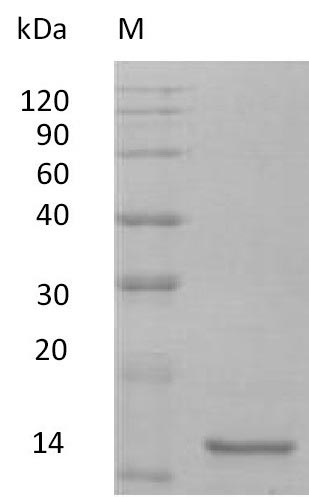The recombinant mouse IL10 protein was produced using an E. coli system. The gene fragment coding for the 19-178aa of mouse IL10 is inserted into a plasmid and then transfected into E.coli for expression. The resulting product is subject to affinity chromatography purification. Its purity exceeds 95% as measured by SDS-PAGE and its endotoxin content is below 0.01 EU/µg as determined by the LAL method. This recombinant mouse IL10 protein has also been validated to be an active protein, with the ED50 of 6 ng/ml as determined in a cell proliferation assay using FDC-P1 Mouse bone marrow cells.
Mouse IL10 is a crucial anti-inflammatory cytokine that plays a significant role in regulating immune responses in mice. It is primarily produced by various immune cells, including B cells, T cells, and macrophages. IL10 is known for its ability to inhibit pro-inflammatory cytokine production, thus maintaining immune homeostasis and preventing excessive tissue damage during inflammatory responses [1][2][3].
In cancer research, IL10 has been shown to enhance tumor immunity by promoting T-cell responses and inhibiting tumor metastasis [1]. It is also implicated in regulating B cell functions, supporting the development of regulatory B cells that produce IL10 in response to specific stimuli, thereby contributing to the suppression of autoimmune responses and maintaining tolerance [4][5]. IL10's ability to limit inflammatory responses is essential in preventing tissue damage during autoimmune attacks. In models of autoimmune diseases, IL10 has been shown to regulate the balance between pro-inflammatory and anti-inflammatory signals, thereby influencing disease progression [2][4].
References:
[1] W. Hu, The central thαβ immunity associated cytokine: il-10 has a strong anti-tumor ability toward established cancer models in vivo and toward cancer cells in vitro, Frontiers in Oncology, vol. 11, 2021. https://doi.org/10.3389/fonc.2021.655554
[2] M. Horikawa, V. Minard‐Colin, T. Matsushita, & T. Tedder, Regulatory b cell production of il-10 inhibits lymphoma depletion during cd20 immunotherapy in mice, Journal of Clinical Investigation, vol. 121, no. 11, p. 4268-4280, 2011. https://doi.org/10.1172/jci59266
[3] H. Bouabe, Y. Liu, M. Moser, M. Bösl, & J. Heesemann, Novel highly sensitive il-10–β-lactamase reporter mouse reveals cells of the innate immune system as a substantial source of il-10 in vivo, The Journal of Immunology, vol. 187, no. 6, p. 3165-3176, 2011. https://doi.org/10.4049/jimmunol.1101477
[4] K. Yanaba, J. Bouaziz, T. Matsushita, T. Tsubata, & T. Tedder, The development and function of regulatory b cells expressing il-10 (b10 cells) requires antigen receptor diversity and tlr signals, The Journal of Immunology, vol. 182, no. 12, p. 7459-7472, 2009. https://doi.org/10.4049/jimmunol.0900270
[5] Y. Iwata, T. Matsushita, M. Horikawa, D. DiLillo, K. Yanaba, G. Venturiet al., Characterization of a rare il-10–competent b-cell subset in humans that parallels mouse regulatory b10 cells, Blood, vol. 117, no. 2, p. 530-541, 2011. https://doi.org/10.1182/blood-2010-07-294249






